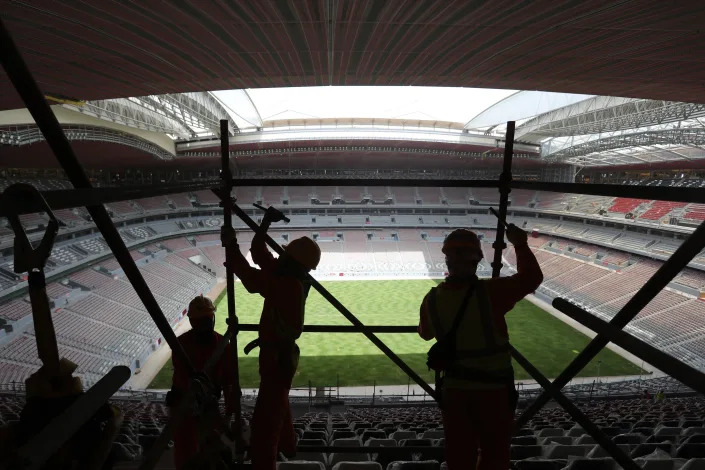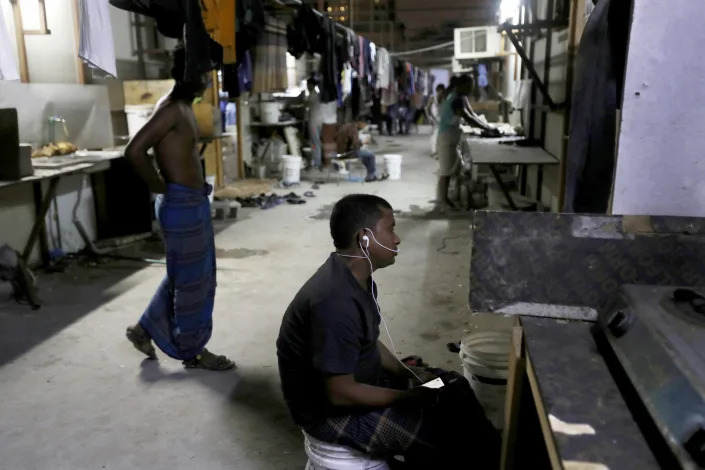Sun, November 6, 2022
Hundreds of Twitter employees on special visas could be deported after Elon Musk's job cuts.
He cut thousands of jobs with the mass layoffs equating to as much as half of the company workforce.
A Forbes report suggests nearly 700 Twitter employees were on H-1B employment-tied visas.
Elon Musk's cost-cutting plans may have left hundreds of Twitter employees on high-skill work visas on a countdown to deportation.
At least 250 Twitter workers appear to be employed on H-1B visas, according to official records, and now face an uncertain future.
And according to analysis of US Citizenship and Immigration Services data by the National Foundation for American Policy, that number could be as high as 670, or 8% of the company pre-cuts, Forbes reported.
Musk began culling the social-media giant's workforce on Thursday night, Insider reported, with access to work applications like Slack suddenly cut off for many now-former employees.
About half of Twitter's workforce, or about 3,700 people, are expected to have lost their jobs, per Insider. But for some of these workers, the consequences could be even more severe.
According to data from the US Citizenship and Immigration Services, Twitter has given "initial approval" to 168 H-1B visas since 2020. The company has received approval for 673 such visas since 2009.
Companies give H-1B visas to people from other countries with "highly specialized knowledge" and a relevant bachelor's degree, per USCIS. They are intended to last for three years, but can go up to six.
If sponsored employment is lost, a migrant has 60 days to find a new job before facing deportation. The US allows 65,000 successful applications a year. Workers on H-1B visas are able to stay in the US if they can find new employment, according to "portability" rules.
Records suggest Immigration Services granted "continuing approval" for 242 visas earlier this year, suggesting hundreds of employment-conditional migrants were working at Twitter before Musk's layoffs.
Musk asked vice presidents to compile lists of employees deemed least worthy of staying as he endeavors to radically alter the way Twitter works. It is unclear what departments visa-tied Twitter employees work for, or how susceptible their positions are to layoffs.
According to immigration law, Musk must pay the "reasonable costs" of transportation of migrant workers whose employment has been terminated before the end of their authorized stays.
According to multiple reports, Musk himself was able to stay in the United States after finishing his college degree thanks to the H-1B visa. He previously reprimanded Donald Trump in 2017 for Trump's decision to suspend the special work visas.
Musk also faces a lawsuit from former employees for not giving adequate notice over mass layoffs, which may provide some from of respite for vulnerable workers. The billionaire has since tweeted that the company offered everyone who got laid off three months' worth of severance, though some staff have disputed his claim.
Twitter user @maybettl, who said they were laid off from the company this week, tweeted that some staff were offering to be laid off to save their colleagues on work visas. Insider wasn't able to verify this information.
Twitter didn't respond to Insider's request for comment on the number of employees on special work visas, or the number of those employees it had laid off.
Jyoti Mann
Sun, November 6, 2022

Twitter laid off nearly half of its workforce on Friday.Getty Images
Twitter employees are posting bad reviews about the company and Elon Musk on anonymous forum Blind.
One person called Musk a "brutalist decision-maker." Another said he has "no idea" what he's doing.
Posting on the day the layoffs were announced, one user said management was causing "stress."
Twitter employees are flooding the employee forum Blind with bad — and some good — reviews about the company and its new CEO, Elon Musk.
Insider trawled through the community app, where employees can anonymously write reviews and post about their workplaces, to see what Twitter staff are saying about the company.
Twitter laid off thousands of employees on Friday when Elon Musk completed his $44 billion takeover of the platform. After axing nearly half of the Twitter workforce, Musk tweeted on Friday that there was "no choice" as the company was losing more than $4 million a day.
Blind requires that users give their work email address, the company they work for, and their job title when they sign up. The site does not verify employment, but requests that people use their work email to "gauge the professional status" of users, Blind's website states.
Users have posted a total of 953 Twitter reviews to the site since 2020 and the company has an overall star rating of 3.8 out of 5 stars. Each poster adds a star rating to their review. Some of the reviews were posted the day some staff members learned of the mass layoffs the next morning, but the majority are from earlier.
One poster who described themself as an engineering manager said on Wednesday: "Brutalist decision-maker at the helm. Emergency driven work is exciting for those who like thrills. Pay is no longer tied to the stock market fluctuations."
The anonymous poster, who gave Twitter a two-star rating, added: "The absolute and swift destruction of a compassionate, human-first corporate culture is leaving Tweeps feeling like we've lost our family."
Another user, who posted the day the company sent staff a memo announcing layoffs, said it "was good until Elon take over."
The self-described senior software developer listed getting to "work for Elon" as a "pro" of working at the company, then put being treated as a "labor robot" on an accompanying list of "cons."
"Sense of achievement on delivering mission critical projects with 24/7 working and sleeping at office," the post said.
A Twitter employee tweeted a picture of a manager sleeping at the office this week after Musk took over. Musk announced plans to launch new product features, including a verification subscription for $8.
A software engineer said on November 2 that before the company was made private, it was an "incredible" place to work.
They added: "Elon mother flipping Musk and his ego the size of mars. Twitter is already chaos, but come layoffs Friday, it will a massive dumpster fire. The man has no idea what he's doing and I'd bet $8 Twitter won't be around or relevant in a couple years."
It is not possible to tell which of these posters, if any, had been laid off.
Another Blind user wrote on Thursday that the management changes are creating "stress" as a result of people being fired or quitting.
Twitter did not respond to Insider's request for comment.
Jing Pan
Mon, November 7, 2022

Not just job cuts: Elon Musk eliminated Twitter's ‘Days of rest’ and work-from-home policies last week — pushing a '24/7' work culture hard. Here are 3 other investments the billionaire likes
If you are a Twitter employee who has a satisfying work-life balance, you may not want to hear what the new boss has to say.
Elon Musk has completed his acquisition of Twitter, despite saying that he overpaid for the company. And now, he’s finding ways to reduce expenditures at the social media giant.
The billionaire entrepreneur cut close to 3,700 jobs at Twitter, or half of the workforce, via email last week.
Musk has also removed Twitter’s “Days of rest” — monthly days off for employees to rest and recharge — in his push to implement a “24/7” work culture.
Additionally, Bloomberg reported that Musk plans to end the company’s remote work policy and ask remaining employees to return to the office full-time.
Jyoti Mann

Elon Musk now owns Twitter.Justin Sullivan/Getty Images
Twitter is still hiring to fill more than 90 roles despite laying off half of its workforce.
Twitter's careers page advertised 92 jobs a day after the mass layoffs.
Twitter posted seven roles on LinkedIn's jobs section a few days before Elon Musk took over.
Twitter is still hiring for more than 90 roles despite the company laying off half of its workforce on Friday.
Twitter's careers page listed at least 92 open roles on Saturday. More than a third of the positions are based at its headquarters in San Francisco.
Twitter first advertised seven roles, all of which are based in London, on LinkedIn two weeks ago. Six jobs are for software engineers, despite one London-based senior engineer being fired while he slept.
Elon Musk sent a memo to Twitter employees on Thursday telling staff they would find out if they were being laid off via email on Friday. Some employees learned their fate on Thursday night after being cut off from accessing their work emails and laptops.
The Tesla founder took control of Twitter last week after his $44 billion deal to buy the platform was complete. He immediately fired top executives including CEO Parag Agrawal, and Ned Segal, the chief financial officer.
Musk later floated new ideas for the company, including charging users $8 to gain a "verified" status along with seeing fewer ads.
A growing chorus of companies including Pfizer, General Motors, and Volkswagen have since paused ads on Twitter amid concerns over the platform's approach to content moderation.
Musk told some of the leading advertisers on the platform in a call that Twitter will have varying tiers of how it would moderate content, likening it to age ratings for films, The Financial Times reported.
Musk then tweeted Friday that Twitter's "strong commitment" to moderating content remained "absolutely unchanged." He also said in another tweet that he had "no choice" but to make mass layoffs because the company was losing $4 million a day.
He said: "Everyone exited was offered 3 months of severance, which is 50% more than legally required." Some Twitter staff have disputed that claim.
Twitter didn't respond to Insider's request for comment.
Elon Musk wants to nickel-and-dime Twitter users for features that were once free just 7 months after saying he 'didn't care about the economics'
Elon Musk is haphazardly suggesting ways to "pay the bills" at Twitter as debt interest payments soon come due.
His approach is starkly different than when he said he "didn't care about the economics" of buying it in April.
Musk has reportedly suggested paid direct messages and "paywalled" videos to advisors as ways to make Twitter more money.
Not long after Elon Musk offered to buy Twitter for $44 billion in April, he said he "didn't care about the economics at all" of the purchase.
"This is just my strong, intuitive sense that having a public platform that is maximally trusted and broadly inclusive is extremely important to the future of civilization," Musk said at the TED2022 conference.
Seven months later, the world's richest man seems to have changed his tune, haphazardly suggesting ideas to his advisors, and even his Twitter followers, in an attempt to make the platform profitable.
Earlier this week, Musk announced that Twitter would begin charging $8 per month for its "blue check" verification program, which was previously free to those who qualified.
"We need to pay the bills somehow!" Musk wrote in a tweet responding to complaints about the fee.
But that's not the only idea Musk has in mind to squeeze cash out of his new company. The New York Times reports that Musk and his advisers have weighed adding a service that would allow users to send direct messages to high-profile users for a fee and "paywalled" videos.
Musk has also considered charging for user analytics and reviving the short-form video platform, Vine, according to his interactions with followers on Twitter.
The rushed attempts to drum up new revenue streams at Twitter are at odds with how Musk spoke about the purchase of the social media platform last spring when he extolled the platform's virtue as a "de facto town square" and compared the Twitter deal to Jeff Bezos' purchase of The Washington Post.
Now, Musk has Twitter employees working 24/7, trying to find a way to make to eke out money from the platform as Twitter will eventually be expected to pay massive interest payments. Musk borrowed $13 billion from banks to partially fund the deal, and the company will have to pay $1 billion in annual interest as a result. Twitter's entire cash flow last year totaled less than $1 billion, according to the Times.
Charging for previously free services isn't the only way Musk has tried to save the company money. On Thursday night and Friday morning, large swaths of Twitter's staff learned they had been laid off, either via email or by simply losing access to their Slack and email accounts.


































